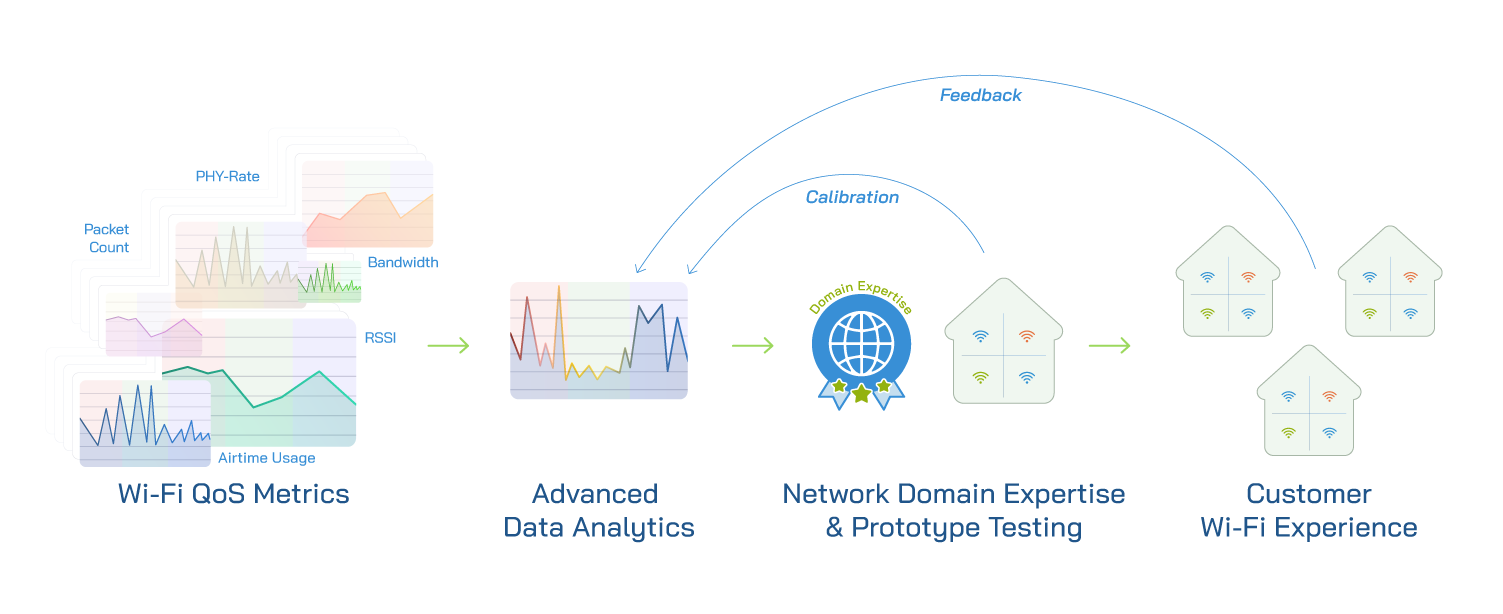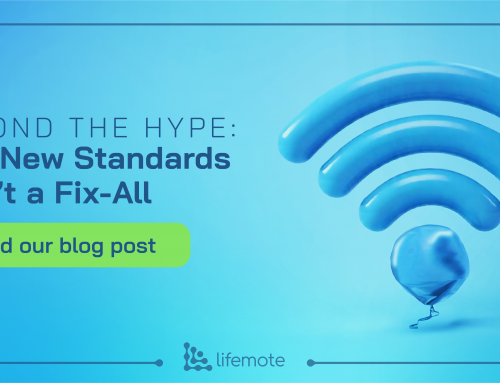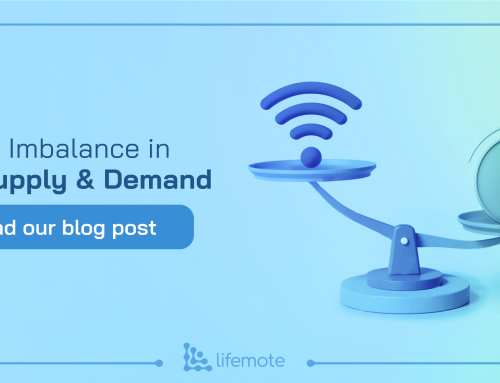The term’ Wi-Fi Assurance’ gives every ISP a warm fuzzy feeling: the sense of order prevailing in the chaos of analyzing and improving wireless in-home performance. But that feeling is short-lived when every ISP CPE team realizes that behind the veneer of strategic AI-driven insights, there is an old-fashioned play at providing QoS data analytics, which may or may not offer the relief to the burning question every ISP is asking: how do we improve the customer experience and tie the data to QoE metrics that matter.
So what’s missing in the Wi-Fi analytics platforms that ISPs typically employ today? Before we search for the missing piece in this data analytics puzzle, it is essential to understand what the puzzle looks like today.
The Assurance Dilemma With Wi-Fi Data Analytics Today
The current state of Wi-Fi data analytics solutions is great in analyzing and providing detailed low-level Wi-Fi network data for troubleshooting and resolving CPE performance issues. They might also offer all the QoS parameters that could give an insight into resolving Wi-Fi performance issues like RSSIs, PHY-rates, and packet loss counts from the CPE installed base.
Some solutions can also correlate RSSI levels with coverage issues and provide insights that may provide short-term relief but might not be able to solve associated Wi-Fi throughput issues observed with specific CPEs. To complicate matters further, most Wi-Fi data analytics platforms may not be compatible with the wide range of CPEs in the market, making their insights valuable to a narrow range of CPE hardware. This constraint might be a challenge for many ISPs, where customers prefer a BYOD approach and fear that data collection from non-compatible CPE hardware might cause performance issues.
But the problem is more profound: analyzing a set of CPEs from an installed base might solve tactical Wi-Fi troubleshooting issues but does not set the stage for an ISP where the technical and product teams can confidently monitor and improve customer experience metrics with these data analytics platforms. Why? Because providing these data analytics directly in the hands of their customer support teams and expecting the 1st and 2nd line team members to upskill in interpreting these insights becomes a massive training challenge for ISP leadership. Not surprisingly, average handling time and truck rolls continue to rise even with the deployment of these data analytics platforms since they are not empowering the support teams to act on these insights effectively.
So which aspects from a data analytics perspective can improve an ISP’s ability to enhance consumer experience? First, let’s discover where the disconnect lies and what can close the gap.
Wi-Fi Assurance and the pieces in the data analytics puzzle
Steve Jobs mentioned this from a consumer hardware perspective, but the analogy also applies well to Wi-Fi experiences. If ISPs can understand the poor quality of experience that a consumer is suffering from and then use the data analytics to interpret and analyze a customer’s issues, the ISPs will be set to succeed in their endeavor to truly improve customer satisfaction metrics.
What can enable this experience-first point of view? For starters, data analytics needs to look outward from a myopic CPE-specific perspective to an overall population-level view of the data and the issues the data provides insight. Suppose an ISP is provided with the ability to look at an entire installed population across a large number of CPEs. In that case, the ability to observe and interpret coverage and performance patterns becomes very effective in solving two specific problems from a Wi-Fi QoE perspective:
- The existence of a particular in-home connectivity issue
- The fact that the customer is suffering from that issue
How can these two elements get discovered with population-level analytics? This is when you add the additional layer of blending two critical criteria:
- Customer NPS scores within the population
- The CPE device spread within the population
Once you can layer these two elements within the existing QoS parameters collected from the CPE installed base, you can now differentiate the true problem areas within the population and what could solve these issues. In addition, if you can learn at scale by using machine learning techniques within the data set to understand population trend patterns in Wi-Fi issues like coverage, congestion, and placement, you would be able to detect frequently better occurring Wi-Fi issues accurately.
The third layer would be to tie these data and insights back to ease of use for the frontline support team to use the insights effectively. For example, if the 1st and 2nd line support teams can interpret these issues quickly and efficiently when they occur, they might be able to resolve calls quickly. Better still, they could also provide proactive care maintenance as these issues arise and work with customers to determine their coverage and performance issues, thus reducing the inbound call volume and increasing customer satisfaction scores in the long term.
Seems like a significant improvement from the Wi-Fi data analytics status quo, so what could possibly be the missing piece in this puzzle? This is where network domain expertise comes in.

Network Domain Expertise: The Piece That Makes Wi-Fi Assurance Complete
With the right blend of detailed population-level and client-level CPE data, and ease of use, ISP teams can easily observe deviant behaviors in Wi-Fi to catch them as (or before) they become a persistent issue. But as an installed base for a given ISP multiplies, the mix of the problems with differing levels of coverage, CPE devices, and installation patterns might introduce a level of complexity that cannot be solved merely by looking at client-level or population-level data. Only one aspect could effectively solve such nuanced issues: research-backed network domain expertise.
If Wi-Fi assurance data platforms can provide a continuous feedback loop of learning from the field and putting expert research insights into the data platform to evolve their insights, they would be able to investigate and catch far-reaching QoE issues before they wreak havoc across the entire population.
For example: If specific CPE models have been experiencing memory issues with newer protocol improvements. Regular research and prototype testing would be able to reveal the CPE models at fault. Once these issues are diagnosed, the data platform could imbibe these newly learned knowledge insights into the platform, notify the ISP team about the affected CPE population, and initiate proactive care before it becomes widespread.
Network domain expertise can become the differentiator between a Wi-Fi assurance platform providing pattern analysis and one that genuinely learns from newer problem areas and provides remediation to the ISP teams relying on proactive Wi-Fi insights.
How Can Lifemote Make Wi-Fi Assurance Complete
If these aspects make you think the following capabilities seem too far-fetched to exist in today’s Wi-Fi assurance data platforms, look no further than Lifemote Networks. Lifemote Networks combines lightweight CPE data collection across a wide range of CPEs, cutting-edge machine learning techniques, and domain expertise to provide your ISP team members with an intuitive experience to your ISP team. Combining this with the ability to diagnose and enable proactive care maintenance with additional tooling capabilities for your technical team to build a self-care mechanism for your in-home subscribers means you can maximize Wi-Fi performance for them and confidently improve customer NPS in the long run.
Experience what expert data insights within a comprehensive Wi-Fi assurance platform could look like – Schedule a demo with Lifemote Networks today.
About the Authors:
 Aysun Önalan
Aysun Önalan
Research Team Lead
aysun.onalan@lifemote.com

Özgün Demir
Research Engineer
ozgun.demir@lifemote.com



